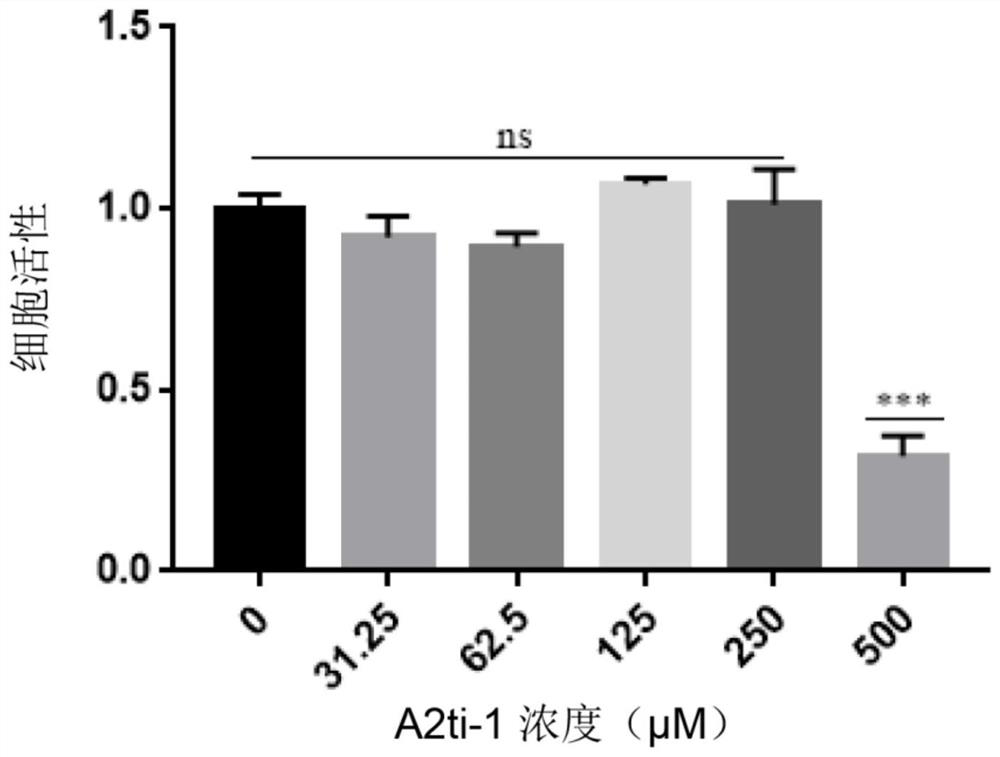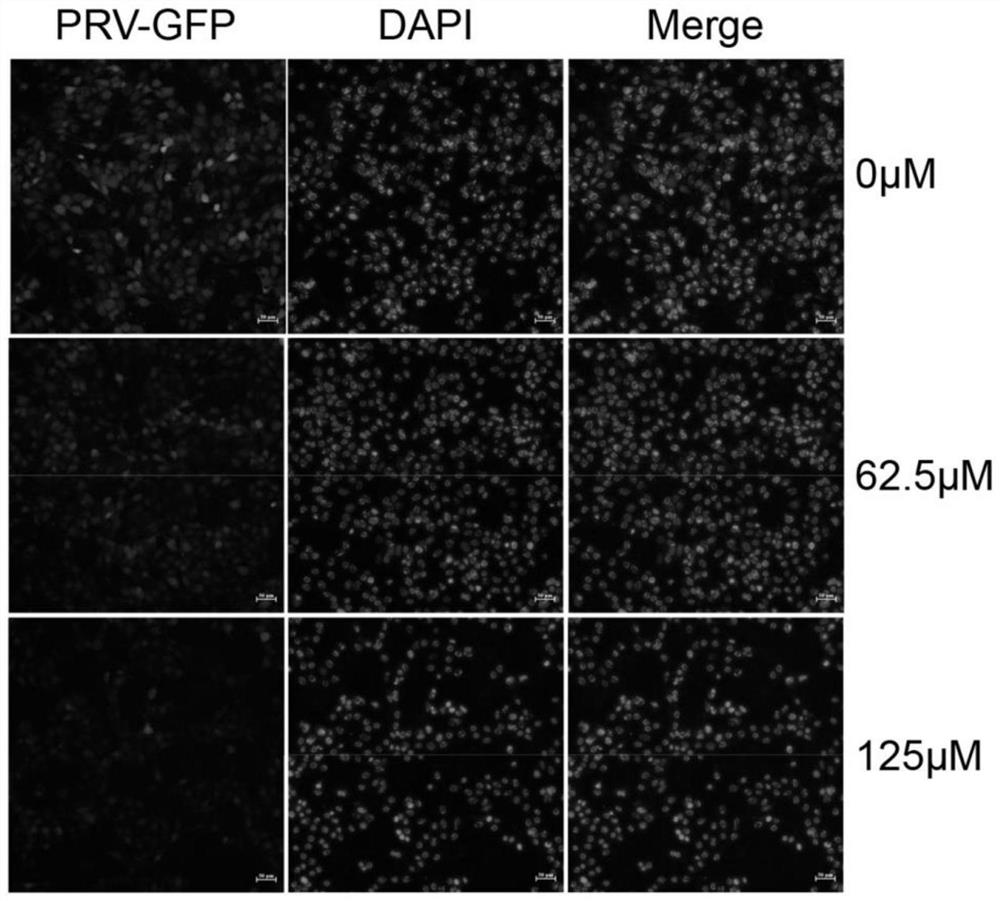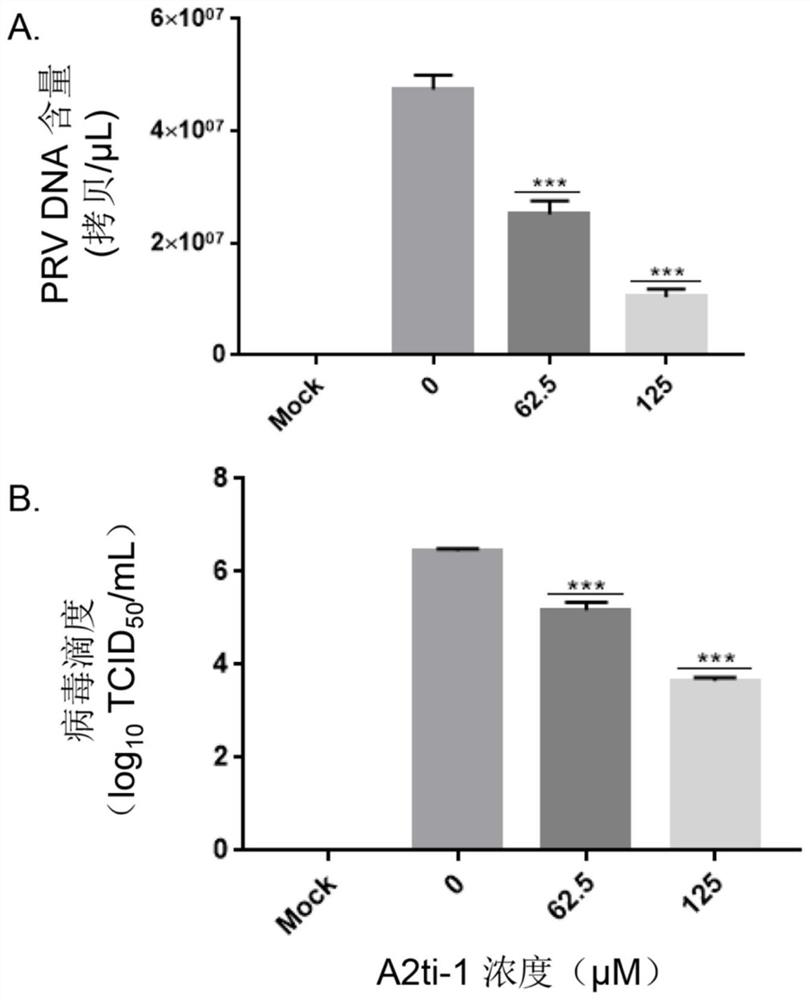Method for inhibiting in-vitro replication and proliferation of pseudorabies virus by using inhibitor A2ti-1 and application
A pseudorabies virus, a2ti-1 technology, applied in the field of cell biology and virology, to achieve the effect of inhibiting replication and proliferation
- Summary
- Abstract
- Description
- Claims
- Application Information
AI Technical Summary
Problems solved by technology
Method used
Image
Examples
Embodiment 1
[0027] Example 1. Detection of cytotoxicity of A2ti-1 on PK-15 cells
[0028] CellTiter 96 AQueous Single Solution Cell Proliferation Assay Kit was used to determine the cytotoxic effect of inhibitors on PK-15 cells.
[0029] (1) PK-15 cells were treated with 1×10 4 Cells / well were plated in a 96-well plate, and the next step could be performed after the cells grew to 70-80% abundance. A blank control was set, and at least three wells were replicated for each concentration.
[0030] (2) Dilution of inhibitors: Dilute A2ti-1 inhibitors with DMEM cell culture medium containing 10% (v / v) FBS (fetal bovine serum), and obtain the concentrations of A2ti-1 inhibitors in the medium as: 0 μM, 31.25μM, 62.5μM, 125μM, 250μM, 500μM.
[0031] (3) Incubation of inhibitors: Discard the old medium, and add 100 μL of inhibitors of corresponding concentration to each well. Place the 96-well plate in a cell culture incubator for 36-48 hours.
[0032] (4) Reading: After adding 20 μL of CellT...
Embodiment 2
[0035] Example 2. Immunofluorescence method to evaluate the inhibitory effect of A2ti-1 on PRV infection
[0036] (1) PK-15 cells were treated with 1×10 4Cells / well were plated in a 96-well plate, and the next step could be performed when the cells grew to about 80% abundance. Set up a blank control. At least three wells were replicated for each concentration.
[0037] (2) Incubate different concentrations of A2ti-1 (0 μM, 62.5 μM and 125 μM) with the PRV-GFP strain (MOI=0.1) at 37°C for 1 hour, rinse with PBS buffer for 3 times, and then add The DMEM cell maintenance solution (containing 2% (v / v) FBS) containing the corresponding concentration of inhibitors was further cultured for 24 hours.
[0038] (3) Discard the culture supernatant, rinse with PBS three times, then add 200 μL of 4% (wt%) paraformaldehyde to each well for fixation for 15 minutes, and then rinse with PBS three times.
[0039] (4) Add 100 μL of DAPI staining solution to each well, stain at room temperatu...
Embodiment 3
[0042] Example 3. A2ti-1 inhibits the dose-dependent evaluation of PRV replication and proliferation
[0043] (1) PK-15 cells were divided into 2.5×10 4 24-well cell culture plate was inoculated with each cell / well, 500 μL DDMEM cell culture medium (containing 10% FBS) was added to each well, and cultured in a cell culture incubator for 24 hours.
[0044] (2) Discard the medium, rinse with PBS for 3 times, and then use the PRV virus (PRV-HeNLH / 2017 strain) with a multiplicity of infection (MOI) of 0.01 and the corresponding concentration of inhibitor A2ti-1 (0μM , 62.5 μM and 125 μM) were added to the cell culture wells and incubated for 1 hour, 0 μM was the control group without inhibitors, and each group had three replicates; discard the medium after incubation, wash the cells with PBS three times, and then add The DMEM cell maintenance solution (containing 2% (v / v) FBS) containing the corresponding concentration of A2ti-1 was further incubated in the cell culture box for 2...
PUM
 Login to View More
Login to View More Abstract
Description
Claims
Application Information
 Login to View More
Login to View More - R&D
- Intellectual Property
- Life Sciences
- Materials
- Tech Scout
- Unparalleled Data Quality
- Higher Quality Content
- 60% Fewer Hallucinations
Browse by: Latest US Patents, China's latest patents, Technical Efficacy Thesaurus, Application Domain, Technology Topic, Popular Technical Reports.
© 2025 PatSnap. All rights reserved.Legal|Privacy policy|Modern Slavery Act Transparency Statement|Sitemap|About US| Contact US: help@patsnap.com



